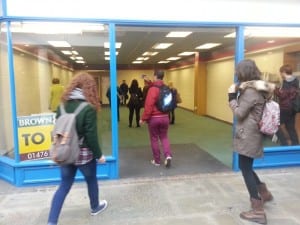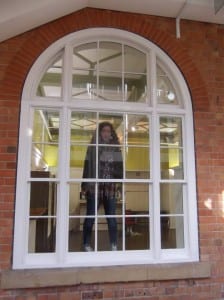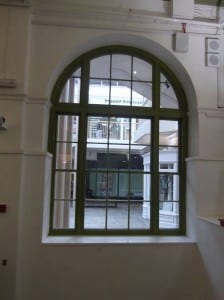“Field implies area, openness. But it is still very crowded – in the crowd. In order to draw attention to itself, performance may need to raise itself above head-height. To lift itself. To suspend itself. To use effects of elevation and falling and floating: fireworks and kites and skydivers. Engaging the full volume or arc of the space. Or it may raise the audience, in arrangements temporary or permanent. The vertical is engaged and viewpoints shift”. (Pearson, 2010, pp. 157).
The concept of destroying preconceived boundaries within a performance space is challenged through our introduction of mirrors. Although, mirroring an entire room (38X22 foot) has its inevitable difficulties, both financially and constructively. A potential development on the idea could be the decision to merely mirror both ceiling and floor, and blacking-out the walls with black cloth material. By doing this we can explore Pearson’s concepts of opening out the “arc of the space” by “engaging the vertical” and shifting the audience viewpoints – whilst (through our own development) engaging the horizontal. Simply by encouraging audience members to lay on the floor, their sensation of reflection on the ceiling gives an illusion of floating in the void, undermining the gravity of the space. By fully altering the positional viewpoint of the audience we can successfully inspire the audience to experience the performance within the space without gravity.
Also, our development of ideas surrounding the “post performance” mirror room being a responsive performance (in itself) to the experience within the space and projecting the pre-recorded responses as an introduction to each consecutive performance will create an instructive reflection on the experience of the individual, and by doing so, narrates a response for further audience members; thus making subsequent performances dependent on interactive participation.
“…wood, for instance is altered, by making a table out of it. Yet, for all that, the table continues to be that common, everyday thing, wood. But, as soon as it steps forth as a commodity, it is changed into something transcendent.” (McLellan, D. (ed.)(2000) Karl Marx: Selected Writings (2nd Edition), New York: Oxford University Press.)
As a group, we may explore the prospect of integrating the audience, taking their presence as tools to shape a line of performance. It is possible to consider that an audience member is capable of becoming a prop. Much the same as we could consider, the space itself as prop or indeed, the mirrors, light, sound, and even the materials used within (and around) the space. Each entity holds the potential to transcend their initial and natural qualities, shifting their existence within the space outside of generic audience “outsiders”, into fully incorporated devices of performance creation.


